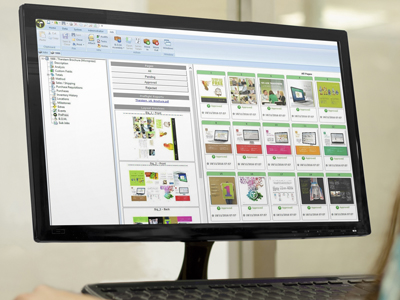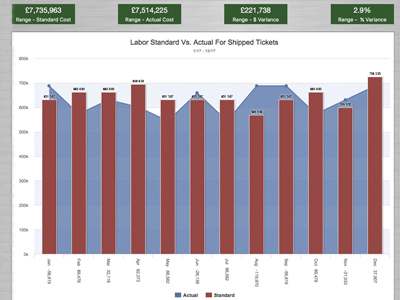EstimateVactual screens help managers stay informed
An MIS can help the whole print production chain run in sync. By bringing order and organisation into the job completion process, printers can streamline their work and eliminate unplanned downtime. Michal Lodej looks at new advances in this technology.
As investments go, management information systems probably have the smallest immediate impact on print room staff. Not a flashy machine or interesting gizmo to play with, but instead something extra to learn and get used to navigating. If you have ever changed mobile phone models, you will know how frustrating using different software can be.
However, once mastered the software can accelerate production and efficiency as well as provide vital information for the management team. The basics of any MIS is to provide fast access to data and improve communication both internally and with customers, streamline and automate workflow, boost throughput and increase profitability, and eliminate errors while maintaining high quality standards.
Freshen the routine
For software based products it is arguably easier to create new products and updates are far more common than in hardware products.
The Label Traxx MIS has been designed and built specifically for the label converting industry, and at the upcoming Labelexpo Europe 2017 exhibition, the company plans to announce three new updates to its program.
One module, Siteline, is aimed at improving customer communication. The communication and collaboration tool makes it easier for customers to do business. Customers can view, sort, filter, search and easily re-order any product produced for them in a self-service fashion online. This removes the need to utilise valuable staff time on re-orders, order status inquiries, and order history questions by giving your customers access to the relevant data.
For the next module, Label Traxx has partnered with sales training provider 3YG to offer a new prospect management tool for label printers aimed at driving revenue growth through improved management of the sales process.
Named Sales Traxx, it uses a dashboard approach to provide an at-a-glance evaluation of the entire company’s sales pipeline. Sales teams, like other aspects of a business can be coached, monitored, tracked and measured to improve performance.
Customers who purchase the Sales Traxx system receive one-on-one sales training for managers, team training and three follow-up dashboard reviews. By the end of the training, users are working live in the software setting up their prospect and customer accounts.
The final new development from Label Traxx is The Business Metrixx module, which is a dashboard designed to provide business owners with key information on the performance of their business. It takes volumes of data from a single source and turns it into easy to understand, visual information. The module is designed to provide best-practice metrics on the entire company performance, allowing management to clearly see trends, monitor progress, and take action where necessary.
Getting specific
Tharstern’s MIS is a fully integrated and modular program that has been made flexo specific and can be configured to meet the individual requirements of a business. Its workflow solutions are now used in over 700 sites with 7,000 users worldwide.

Tharstern MIS with pre-press workflow feedback
Users can configure flexo presses, to drive the estimating process, taking into account flexo-specific factors such as cylinder dimensions.
The intelligent estimating software dynamically calculates costs based on a range of available equipment and media. Users are then presented with multiple options and can select quotes based on best price, different production options and best margin.
The different modules are integrated together, and other key software and hardware is too, which reduces admin and data rekeying and improves workflow efficiency.
Tharstern’s latest release is its Business Intelligence module, which it says is a smarter way for users and key decision makers to view MIS information and create actionable analytics.
Using a clean and intuitive drag and drop interface, users can investigate relationships and trends previously only possible by expensive and time consuming database query and analysis.
Even users without specialist database or development skills can create and share spectacular infographics and charts based on information directly from their MIS.
The MIS has an open API which means that it is possible for other applications to share data with the system and to take actions on its behalf (and vice versa). This makes integration with similarly enabled technology much simpler and helps futureproof customers against any technological advancements they may want to deploy in the future.
Suite solutions
Version five of the EFI Packaging Suite, a packaging and label converting solution, offers comprehensive business and production workflows that increase enterprise-wide profitability. The suite, which features EFI Radius as its core ERP software, includes enhancements in estimating, job planning and shop floor data collection.
The software offers higher levels of efficiency and cost optimisation, improving label and package converting operations by giving users visibility across the business so they can make informed, proactive decisions and providing robust, real-time scheduling that can maximise productivity by efficiently responding to process changes and interruptions across the enterprise.
Packaging operations can configure their individual Packaging Suite workflow to address the specific production management needs for products they offer, including folding cartons, labels, shrink sleeves, in-mould labels, flexible packaging and blown film extrusion products.
The suite’s intelligent estimating and job planning component, which was previously available for folding carton converters, now also supports label manufacturing. Its intuitive, browser-based interface offers a highly visual step-by-step workflow and the flexibility to customise production steps during implementation to meet specific operational needs. And, its high levels of automation can significantly reduce the learning curve for less-experienced employees.
The component consolidates estimating and production knowledge in a centralised shared database, so users can leverage organisational knowledge to work smarter and make the estimating process faster and more predictable. Automated production planning determines the most cost-efficient job path, and instant edit impact analysis provides a full audit trail as plans progress.
Abbey Labels finds its SolPrint
For over 15 years, SolPrint has worked with Barry Pettit from Abbey Labels; a label printing company that is situated in East Anglia. They have used it to aid the printing process from estimating costs for the customer, managing the production of the labels to invoicing the customer at the end.
Abbey Labels prints over 27 different types of products and aims for a fast turnaround. The need for an MIS is crucial for the company, as they work with a variety of clients from different business sectors such as food, beverages, cosmetics, chemical industries and even microbreweries. The MIS has enabled the company to have its client’s printing process and information all in one place, so that it can retain quality and efficiency.
‘We have used SolPrint for many years now. As the system has developed, we have developed with it,’ Barry Pettit, managing director of Abbey Labels, explained. ‘We know there are other MIS systems on the market, but we have found SolPrint particularly good because of its cutter software, which makes the job easier when it comes to estimating costs for clients.’
One of the main benefits Abbey Labels found using the software is that all of the information and data is in one place with easy to access on the system.
Barry Pettit and the team at Abbey Labels are also now using the new SolPrint Customer XN, which is web-enabled and allows customers to have their own login to securely view and enter information directly into the program. Customer XN enables the system to either automatically respond to the customer’s request with a predetermined response or the customer enquiry can be sent directly to you for authorisation. This way, Customer XN will help you save even more time and quicken the printing process within your business.
Along with Customer XN, the company has launched a new proofing functionality as part of the Digital Asset Management System (DAMS), where digital images can be stored and tagged for each individual client. This allows clients to access SolPrint so they can proof and approve their work online, enabling fast accurate response between them and the client.
Read the full June issue here






